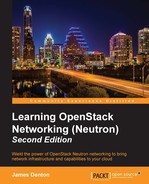Neutron introduces support for third-party plugins and drivers that extend network functionality and implementation of the Neutron API. Plugins and drivers can be created that use a variety of software- and hardware-based technologies to implement the network built by operators and users.
There are two major plugin types within the Neutron architecture:
- Core plugin
- Service plugin
A core plugin implements the core Neutron API and is responsible for adapting the logical network described by networks, ports, and subnets into something that can be implemented by the L2 agent and IP address management system running on the host.
A service plugin provides additional network services such as routing, load balancing, firewalling, and more.
In this book, the Modular Layer 2 core plugin is discussed.
The following service plugins will be covered in later chapters:
- Router
- Load balancer
- Firewall
- Virtual private network
Note
The Neutron API provides a consistent experience to the user despite the chosen networking plugin. For more information on interacting with the Neutron API, visit http://developer.openstack.org/api-ref-networking-v2.html.
Prior to the inclusion of the Modular Layer 2 (ML2) plugin in the Havana release of OpenStack, Neutron was limited to using a single core plugin at a time. The ML2 plugin replaces two monolithic plugins in its reference implementation: the LinuxBridge plugin and the Open vSwitch plugin. Their respective agents, however, continue to be utilized and can be configured to work with the ML2 plugin.
The ML2 plugin introduced the concept of type drivers and mechanism drivers to separate the types of networks being implemented and the mechanisms for implementing networks of those types.
An ML2 type driver maintains type-specific network state, validates provider network attributes, and describes network segments using provider attributes. Provider attributes include network interface labels, segmentation IDs, and network types. Supported network types include local, flat, vlan, gre, and vxlan.
An ML2 mechanism driver is responsible for taking information established by the type driver and ensuring that it is properly implemented. Multiple mechanism drivers can be configured to operate simultaneously, and can be described using three types of models:
Mechanism drivers to be discussed in this book include:
- LinuxBridge
- Open vSwitch
- L2 Population
The LinuxBridge and Open vSwitch ML2 mechanism drivers are used to configure their respective switching technologies within nodes that host instances and network services. The LinuxBridge driver supports local, flat, vlan, and vxlan network types, while the Open vSwitch driver supports all of those as well as the gre network type.
The L2 population driver is used to limit the amount of broadcast traffic that is forwarded across the overlay network fabric. Traditional switching behavior dictates that unknown unicast, multicast, and broadcast traffic is flooded out all switch ports until the location is learned. This behavior can have a negative impact on the overlay network fabric, especially as the number of hosts in the cloud scales out. As an authority on what instances and other network resources exist in the cloud, Neutron can prepopulate forwarding databases on all hosts to avoid a costly learning operation. When ARP proxy is used, Neutron prepopulates the ARP table on all hosts in a similar manner to avoid ARP traffic from being broadcast across the overlay fabric.
The following diagram demonstrates at a high level how the Neutron API service interacts with the various plugins and agents responsible for constructing the virtual and physical network:

Figure 3.1
The preceding diagram demonstrates the interaction between the Neutron API, Neutron plugins and drivers, and services such as the L2 and L3 agents. For more information on the Neutron ML2 plugin architecture, refer to the OpenStack Neutron Modular Layer 2 Plugin Deep Dive video from the 2013 OpenStack Summit in Hong Kong available at https://www.youtube.com/watch?v=whmcQ-vHams.
Third-party vendors such as PLUMGrid and OpenContrail have implemented support for their respective SDN technologies by developing their own monolithic or ML2 plugins that implement the Neutron API and extended network services. Others, including Cisco, Arista, Brocade, Radware, F5, VMWare, and more, have created plugins that allow Neutron to interface with OpenFlow controllers, load balancers, switches, and other network hardware. For a look at some of the commands related to these plugins, refer to Appendix A, Additional Neutron Commands.
Note
The configuration and use of these plugins is outside the scope of this book. For more information on the available plugins for Neutron, visit http://docs.openstack.org/admin-guide-cloud/content/section_plugin-arch.html.
